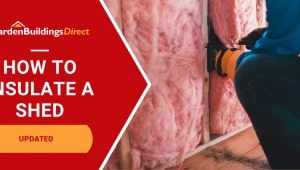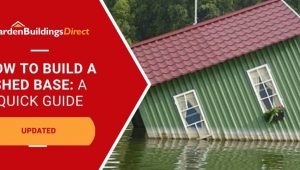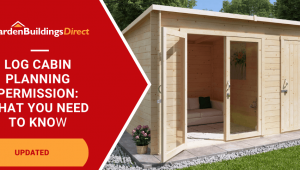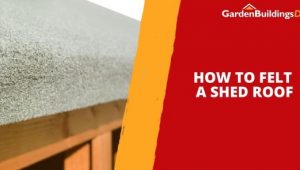Jump to:
A shed on gravel looks like the easy route. Tip a load of gravel down, level it off, and job done. But the question is, will the structure stay upright or start shifting in the long run? Here’s what you should know before you go down that road.
Still shopping for your new shed? Our shed buying guide covers everything from materials to roof styles to help you make the best choice.
Can You Build a Shed on Gravel?
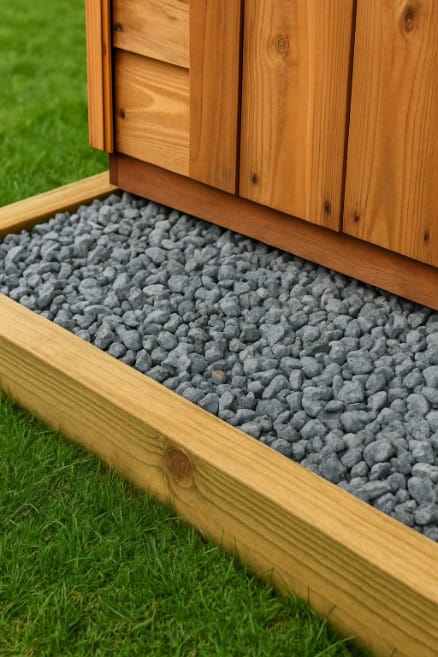
Yes, you can build a shed on gravel, but it depends on how you set it up. Gravel is only as good as the way you prepare and contain it. If you just throw it down on the ground, it will only stay as stable as the ground beneath it.
Before laying any gravel, it’s best to prepare the ground underneath. Start by removing the turf or topsoil until you reach firm subsoil, then compact it using a tamper or plate compactor. A solid, even surface prevents the gravel from settling unevenly. For extra stability, many shed base installers also add a thin layer of hardcore (MOT Type 1 or crushed stone) beneath the gravel to spread the load and improve drainage. This step creates a firm foundation that won’t shift when the shed is in place.
The gravel needs to be well contained within a framed area. You can build this from wood, or use a plastic base kit. Then, there needs to be enough gravel to adequately fill this frame to provide a level surface on top.
Where it fails is when the ground underneath isn’t level, or the gravel has no boundary. In that case, the shed tilts, gaps open around the floor, and doors don’t line up.
Best Practice for Gravel in a Base Frame
As mentioned, the shed will hold better when the gravel is contained in a frame.
What you’ll need:
- Treated timber for the frame
- Stakes or screws to pin the frame
- Gravel, around 40mm down to dust (aka crushed stone fines or Type 1 limestone)
- A tamper or plate compactor
- Weed control membrane or landscape fabric
Before placing the frame, prepare the soil by digging down 2–3 inches and removing any soft spots or organic material. Compact the soil thoroughly and lay down a weed control membrane or landscape fabric. This helps stop plants from growing through the gravel and prevents soil from mixing upward into the base over time. On wetter or clay-heavy ground, it also makes sense to add a layer of hardcore (rough crushed stone) beneath the gravel for added drainage and long-term support.
How to lay gravel in a base frame
- Clear and level the ground where the shed will go.
- Build a square or rectangular frame from treated timber, then fix it down.
- Fill the frame with gravel to a depth of about 4 to 6 inches.
- Pack the gravel down until the surface is solid and flat.
- Place the shed on top and secure it to the frame to stop any movement.
Why use a frame? It holds the gravel in place, keeps the surface level, and makes it easier to anchor the shed. Without it, the gravel can shift over time, and that’s when sheds start to lean.
Drainage and Moisture Control
Drainage is one of the biggest reasons people choose gravel for a shed base. However, poor preparation means the gravel won’t drain as expected.
The pad should have a slight slope around the edge. Even a small fall away from the shed is enough to guide water off. Laying a weed block or landscape fabric under the gravel also helps long-term. For one, it keeps soil from mixing into the gravel and stops weeds creeping up through the base.
Proper drainage begins with good ground preparation. If the soil holds water or tends to get muddy, add a base layer of MOT Type 1 or hardcore beneath the gravel to promote runoff and prevent standing water under the shed. Always install a weed control fabric before spreading the gravel — this separates soil and stone, reduces weed growth, and extends the life of the foundation.
Make the pad wider than the shed by at least a few inches on every side. This ensures rainwater falls onto gravel instead of bare ground. If it reaches the soil edge, it can wash gravel out from underneath and leave the shed uneven.
FAQ
How thick should the gravel be?
Go for at least 4 to 6 inches. That depth spreads the weight of the shed and keeps the floor stable. Anything thinner will shift, and the shed will start to lean.
What gravel size works best for a shed foundation?
Medium-sized gravel or crushed stone is best, around 20 to 40mm. Smaller gravel locks together better than big stones. Meanwhile, crushed stone compacts more than rounded pea gravel.
Can pests burrow under gravel?
Yes, they can. Rats and other pests may still dig through loose ground under the gravel. A layer of wire mesh or hardcore under the pad makes it harder for them to get in.
Is gravel cheaper than concrete?
In most cases, yes. Gravel usually costs less upfront and takes less time to install. In contrast, concrete is stronger and lasts longer, but it’s more expensive and needs more work to put down.
Learn more here: Building a Shed on Grass – Expert Shed Base Advice
